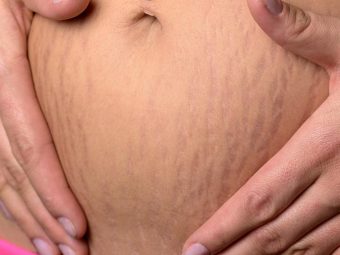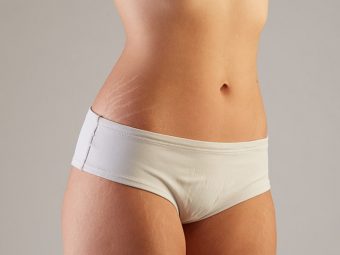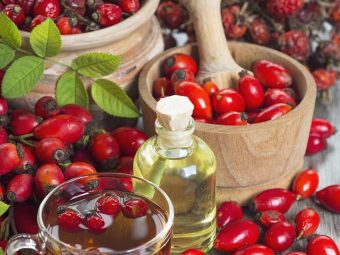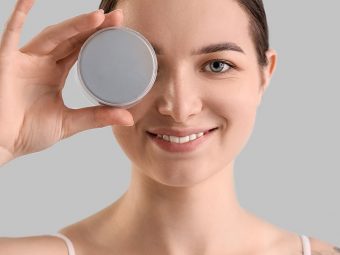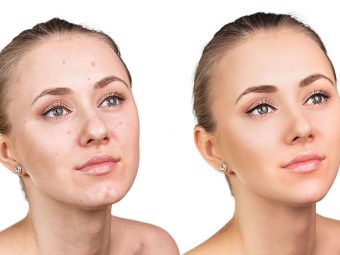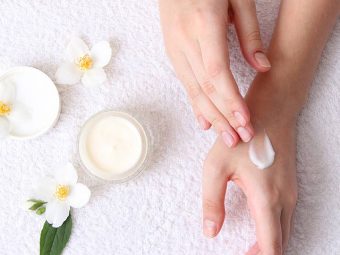Is Olive Oil Good For Stretch Marks? How To Use It
Understand the therapeutic effects of olive oil for stretch marks and learn easy-to-follow recipes.

Image: Shutterstock
Stretch marks are purple or silver thin lines that can develop due to several reasons such as weight gain or pregnancy. While commonly seen on your thighs, hips, buttocks, or abdomen, it can make you feel conscious and not so comfortable. Stretch marks fade as time passes, but you can use natural remedies to reduce their appearance. While many studies don’t favor olive oil for stretch marks, some people believe that using it is one of the best ways to reduce them. In this article, we look at some of the benefits and risks along with a few home remedies for olive oil you can use for stretch marks.
In This Article
Can Olive Oil Help Treat Stretch Marks?
No. As per studies, olive oil does not have any impact on stretch marks.
- A study found that applying olive oil could not prevent the development of stretch marks in primigravidae (women who were pregnant for the first time) (1).
- In another study performed on subjects in their second trimester of pregnancy, the intervention group massaged olive oil on abdominal skin twice a day, while the control group did not use any oil.
Around 40% of the subjects in the intervention group and 50% of the subjects in the control group developed stretch marks. The researchers concluded that olive oil was not effective in reducing the occurrence of stretch marks by the end of the second trimester (2).
- Another study evaluating the effect of olive oil came to a similar conclusion. The randomized controlled clinical trial involved 100 nulliparous pregnant women (women who gave birth to a stillborn baby or didn’t give birth yet). Fifty women in the treatment group applied 1 cc olive oil twice a day on the abdominal skin until delivery. The control group did not apply anything at all.
The study found that the frequency of severe stretch marks was lower in the group that used olive oil, but there was no statistical difference in the results of both the treatment and control groups. Olive oil increased the development of mild stretch marks. The study concluded that olive oil could not prevent stretch marks (3).
However, one non-experimental study found a link between olive oil and lower incidence of stretch marks (4).
Most studies found olive oil not suitable for the skin for the following reasons:
- It may aggravate atopic dermatitis and xerosis (abnormal skin dryness) (5).
- It affects the skin barrier and causes erythema (redness due to inflammation) (6).
- It affects increases the rate of transepidermal water loss (TEWL), which means that your skin loses moisture fast. This affects the natural skin barrier (7).
On the other hand, olive oil was also found to have wound healing, anti-inflammatory, and antioxidant effects when applied topically. However, the study was done on mice, and olive oil may not have the same effect on human skin (8).
The graph below shows the minimum and maximum levels of the main antioxidants found in extra virgin olive oil. The data was taken from a 2020 study published in Antioxidants in which oil samples were used from different regions of Italy. As depicted in the graph, tocopherols (vitamin E) and secoiridoids are the primary contributors to olive oil’s antioxidant activity. This shows that olive oil is brimming with antioxidants that may boost skin health.
Concentration Of The Main Antioxidants In Extra Virgin Olive Oil
Source: Antioxidants in Extra Virgin Olive Oil and Table Olives: Connections between Agriculture and Processing for Health Choices Trivia
TriviaIf you want to go ahead and use olive oil for stretch marks, use it along with other skin-protecting and nourishing ingredients. Here are a few DIY remedies that you may try.
How To Use Olive Oil For Stretch Marks
Note: When using olive oil, make sure you are using cold-pressed or extra virgin olive oil.
1. Olive Oil And Shea Butter

Shea butter is widely used in skin care and cosmetics products, especially moisturizers. Any cream containing shea butter has the same effect on the skin as ceramidei XA family of lipids that act as a glue between skin cells, thus keeping the skin barrier intact and healthy. -containing products (9).
You Will Need
- 1 tablespoon of raw shea butter
- 1 teaspoon of cold-pressed olive oil
Method
- Mix shea butter and olive oil.
- Massage the stretch marks with the mixture.
- Leave it on overnight.
- Repeat every day.
2. Olive Oil And Coffee Grounds
There is no proof that scrubbing can reduce stretch marks. However, using coffee grounds for scrubbing may help get rid of dead skin cells and keep the area soft.
You Will Need
- 1 tablespoon of coffee grounds
- 1-2 teaspoons of cold-pressed olive oil
Method
- Mix the coffee grounds and olive oil.
- Scrub the stretch marks with the mixture for 5 minutes.
- Leave it on for another 5 minutes.
- Wash off and apply a moisturizer.
- You can use this as a body scrub.
- Repeat thrice a week.
3. Olive Oil And Coconut Oil
Coconut oil prevents TEWL or transepidermal water loss to keep your skin moisturized. It also protects the skin from sun damage or UV damage (10). Additionally, it provides hydration and nourishment as well.
You Will Need
- 1 tablespoon of cold-pressed coconut oil
- 1 teaspoon of cold-pressed olive oil
Method
- Microwave the coconut oil for a few seconds (optional).
- Mix the two oils.
- Massage the oil blend onto the stretch marks.
- Leave it on overnight.
- Repeat every day.
Caution: Olive oil absorption into the skin takes time. Anecdotal evidence suggests that this heavy oil can act as a breeding ground for bacteria, clog pores, and cause acne. Therefore, do not use this remedy if you have oily, combination, or acne-prone skin and if you frequently get pimples on your face or body.
4. Olive Oil And Turmeric
Turmeric may not have any direct effect on stretch marks, but it has a therapeutic impact on your skin and can keep it healthy (11).
You Will Need
- ½ teaspoon of turmeric powder
- 1 tablespoon of cold-pressed olive oil
Method
- Mix the turmeric and olive oil.
- Massage it onto your stretch marks.
- Leave it on for at least half an hour.
- Wash it off and apply a moisturizer.
- Repeat every day.
5. Olive Oil And Aloe Vera
Aloe vera contains mucopolysaccharides that help bind moisture to your skin. It also promotes the development of collagen and elastin fibres (12). This may improve skin elasticity and reduce the appearance of stretch marks.
You Will Need
- 1-2 tablespoons of fresh aloe vera pulp
- ½ teaspoon of cold-pressed olive oil
Method
- Whisk the aloe vera pulp and olive oil in a bowl.
- Massage the mixture onto your stretch marks.
- Leave it on for 20-30 minutes.
- Wash it off and apply a moisturizer.
- Repeat every day.
6. Olive Oil And Brown Sugar
The coarse sugar scrub is a natural way of sloughing off the dead skin cells and dirt from the skin. This helps to keep your skin soft and smooth. Anecdotal evidence suggests that this scrub may help with stretch marks prevention.
You Will Need
- 2 tablespoons of brown sugar
- 1 tablespoon of cold-pressed olive oil
Method
- Mix the sugar and oil.
- Scrub your stretch marks with the mixture for 5 minutes.
- Wash it off and apply a moisturizer.
- Repeat once every two days.
7. Olive Oil And Bitter Almond Oil
A study found that massaging the stretch marks for 15 minutes with bitter almond oil during pregnancy reduced the development of stretch marks (13).
You Will Need
- 2-3 drops of bitter almond oil
- A tablespoon of cold-pressed olive oil
Method
- Mix the two oils.
- Massage your stretch marks with the oil mixture for 15 minutes.
- Leave it on for some time and wash it off.
- Repeat every day.
8. Olive Oil And Lemon
Lemon is a rich source of vitamin C. Studies show that vitamin C boosts collagen production, which makes the skin look smoother. While the topical application of vitamin C is common, its efficacy compared to dietary intake is unclear. Additionally, research suggests that vitamin C has great potential for improving skin texture as well (15). Thus, it may be effective in reducing the appearance of stretch marks.
You Will Need
- 2-3 tablespoons of olive oil
- Juice of half a lemon
Method
- Mix the olive oil and lemon juice well.
- Massage the mixture onto your stretch marks.
- Leave it on for about 15 minutes, then rinse it off.
- Repeat this process daily for the best results.
These are a few ways to use olive oil for treating stretch marks. However, you need to be careful while using it.
Precautions While Using Olive Oil For Stretch Marks
Olive oil may not be the right choice for topical application as it may:
- Cause skin dryness
- Aggravate atopic dermatitisi XItchy inflammation of the skin that commonly develops in children and individuals with a family history of the condition.
- Affect the skin’s natural barrier
- Cause redness
If you have any skin condition, such as atopic dermatitis or eczema, it is better to avoid olive oil. Also, if you have sensitive skin, avoid olive oil. There is a possibility that you might be allergic to olive oil. Hence, do a patch test before using it.
If you are keen on using olive oil for stretch marks and scars, always opt for good quality, cold-pressed olive oil. Also, make sure that you are storing it in a glass bottle, away from direct sunlight and moisture. Otherwise, it may turn rancid. In case of any adverse effects, contact your doctor immediately.
Infographic: 3 Ways To Use Olive Oil For Stretch Marks
If you are exhausted from spending money on useless stretch mark products, it’s time to try olive oil. This conventional oil is a potent source of antioxidants and nutrients that are good for the skin and can improve the appearance of stretch marks. See the infographic below for 3 simple ways to use olive oil for those stubborn stretch marks. Illustration: StyleCraze Design Team
Stretch marks fade with time, but you can also reduce them with the help of home remedies like olive oil. Though there are not enough studies to support the efficiency of olive oil for stretch marks, it is believed that using olive oil may help reduce these marks. Studies have also found that olive oil may increase abnormal skin dryness and cause skin inflammation. Also, you can use olive oil as a scrub or massage oil to keep your skin soft and smooth. However, do a patch test before applying it to your skin to prevent skin sensitivity and side effects.
Frequently Asked Questions
What kind of olive oil is best for stretch marks?
Olive oil may not fade stretch marks. However, if you want to try it out, use cold-pressed or extra virgin olive oil.
Does olive oil fade stretch marks?
No. Studies state that it may not be suitable for your skin and can cause dryness and moisture loss.
How long do stretch marks take to fade?
Stretch marks usually take about 3 to 6 months to fade and almost a year to mature and disappear.
Does olive oil lighten skin?
Olive oil doesn’t have skin-lightening effects. But it does offer mild UV protection, and potentially helps reduce redness and wrinkles. It also tones the skin (14).
Key Takeaways
- Stretch marks occur when the skin is stretched too quickly due to rapid weight gain or loss.
- Research shows that olive oil does not help reduce stretch marks.
- Olive oil may worsen atopic dermatitis and xerosis. It causes redness and increases moisture loss from the skin, which affects your skin barrier.
- Pair olive oil with replenishing ingredients like shea butter, coffee, coconut oil, turmeric, and aloe vera.

Image: Stable Diffusion/StyleCraze Design Team
Check out the video below and learn how to use olive oil to reduce the appearance of stretch marks. Get tips on the best way to apply it for maximum results and bid goodbye to those pesky marks easily!
References
Articles on StyleCraze are backed by verified information from peer-reviewed and academic research papers, reputed organizations, research institutions, and medical associations to ensure accuracy and relevance. Read our editorial policy to learn more.
- Brennan, Miriam, Mike Clarke, and Declan Devane. “The use of anti stretch marks’ products by women in pregnancy: a descriptive, cross-sectional survey.” BMC pregnancy and childbirth 16.1 (2016): 276.
https://www.ncbi.nlm.nih.gov/pmc/articles/PMC5031338/ - Taavoni, Simin, et al. “Effects of olive oil on striae gravidarum in the second trimester of pregnancy.” Complementary therapies in clinical practice 17.3 (2011): 167-169.
https://pubmed.ncbi.nlm.nih.gov/21742284 - Soltanipoor F, Delaram M, Taavoni S, Haghani H. The effect of olive oil on prevention of striae gravidarum: a randomized controlled clinical trial. Complement Ther Med. 2012;20(5):263–266.
https://pubmed.ncbi.nlm.nih.gov/22863639 - Davey, C. M. H. “Factors associated with the occurrence of striae gravidarum.” BJOG: An International Journal of Obstetrics & Gynaecology 79.12 (1972): 1113-1114.
https://obgyn.onlinelibrary.wiley.com/doi/abs/10.1111/j.1471-0528.1972.tb11896.x - Karagounis, Theodora K., et al. “Use of “natural” oils for moisturization: Review of olive, coconut, and sunflower seed oil.” Pediatric dermatology 36.1 (2019): 9-15.
https://onlinelibrary.wiley.com/doi/full/10.1111/pde.13621 - Danby, Simon G., et al. “Effect of olive and sunflower seed oil on the adult skin barrier: implications for neonatal skin care.” Pediatric dermatology 30.1 (2013): 42-50.
https://pubmed.ncbi.nlm.nih.gov/22995032 - Darmstadt, Gary L., et al. “Impact of topical oils on the skin barrier: possible implications for neonatal health in developing countries.” Acta Paediatrica 91.5 (2002): 546-554.
https://pubmed.ncbi.nlm.nih.gov/12113324 - Donato-Trancoso, Aline, Andréa Monte-Alto-Costa, and Bruna Romana-Souza. “Olive oil-induced reduction of oxidative damage and inflammation promotes wound healing of pressure ulcers in mice.” Journal of dermatological science 83.1 (2016): 60-69.
https://pubmed.ncbi.nlm.nih.gov/27091748 - Hon, K. L., et al. “Patient acceptability, efficacy, and skin biophysiology of a cream and cleanser containing lipid complex with shea butter extract versus a ceramide product for eczema.” Hong Kong Med J 21.5 (2015): 417-25.
https://pubmed.ncbi.nlm.nih.gov/26314567 - Evangelista, Mara Therese Padilla, Flordeliz Abad‐Casintahan, and Lillian Lopez‐Villafuerte. “The effect of topical virgin coconut oil on SCORAD index, transepidermal water loss, and skin capacitance in mild to moderate pediatric atopic dermatitis: a randomized, double‐blind, clinical trial.” International journal of dermatology 53.1 (2014): 100-108.
https://pubmed.ncbi.nlm.nih.gov/24320105 - Vaughn, Alexandra R., Amy Branum, and Raja K. Sivamani. “Effects of turmeric (Curcuma longa) on skin health: a systematic review of the clinical evidence.” Phytotherapy Research 30.8 (2016): 1243-1264.
https://pubmed.ncbi.nlm.nih.gov/27213821 - Surjushe, Amar, Resham Vasani, and D. G. Saple. “Aloe vera: a short review.” Indian journal of dermatology 53.4 (2008): 163.
https://www.ncbi.nlm.nih.gov/pmc/articles/PMC2763764/ - Timur Taşhan, Sermin, and Ayşe Kafkasli. “The effect of bitter almond oil and massaging on striae gravidarum in primiparaous women.” Journal of clinical nursing 21.11‐12 (2012): 1570-1576.
https://pubmed.ncbi.nlm.nih.gov/22594386 - Kaur CD, Saraf S. In vitro sun protection factor determination of herbal oils used in cosmetics. Pharmacognosy Res. 2010 Jan;2(1):22-5.
https://www.ncbi.nlm.nih.gov/pmc/articles/PMC3140123/ - Pullar, Juliet M., Anitra C. Carr, and Margreet Vissers. “The roles of vitamin C in skin health.” Nutrients 9.8 (2017): 866.
https://www.ncbi.nlm.nih.gov/pmc/articles/PMC5579659/









 Quick Tip
Quick Tip




